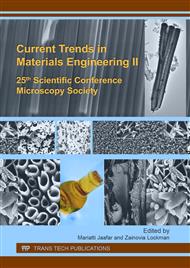[1]
J.B. Olivato, A.P. Bilck, F. Yamashita. Effect of organic acids as additives on the performance of thermoplastic starch/polyester blown films. Carbohydrate Polymers, 90, (2012), 159– 164.
DOI: 10.1016/j.carbpol.2012.05.009
Google Scholar
[2]
Xiaofei Ma, J. Y. The plastcizers containing amide groups for thermoplastic starch. Carbohydrate Polymers, 57, (2004), 197–203.
DOI: 10.1016/j.carbpol.2004.04.012
Google Scholar
[3]
Yachuan Zhang, Thermoplastic Starch Processing and Characteristic-A Review. Food Science and Nutrition 54, (2014), 1353-1370.
Google Scholar
[4]
Jiugao, Y., Wang N., Ma X. The Effect of Citric Acid on the Properties of Thermoplastic Starch Plasticized by Glycerol. Starch/Starke, 57, (2005), 494-504.
DOI: 10.1002/star.200500423
Google Scholar
[5]
Zuraida, A., Yusliza, Y., Anuar, H., Mohd Khairul Muhaimin, R. The effect of water and citric acid on sago starch bio-plastics. International Food Research Journal, 19(2), (2012), 715-719.
Google Scholar
[6]
Zhu, F. Composition, structure, physicochemical properties, and modifications of cassava starch. Carbohydrate Polymers, 122, (2015), 456–480.
DOI: 10.1016/j.carbpol.2014.10.063
Google Scholar
[7]
Sudarat. J, Vanee. C, Onanong. N, Ngamtip. P, Modification of cassava starch by esterification and properties of cassava starch ester film. Kasetsart Journal, 40, (2006), 148-157.
Google Scholar
[8]
Colussi. R, El Halal. S. L. M, Pinto. V. Z, Bartz. J, Gutkoski. L. C, Zavareza. E. Da Rosa, Dias. A. R. G, Acetylation of rice starch in an aqueous medium for use in food. Food Science and Technology Journal, 62, (2015), 1076-1082.
DOI: 10.1016/j.lwt.2015.01.053
Google Scholar
[9]
Paula G.S., Carolina M. J., Fucia F., Silvia G. Biodegradable and non-retrogradable eco-films based on starch-glycerol with citric acid as crosslinking agent. Carbohydrate Polymers, 138, (2016), 66-74.
DOI: 10.1016/j.carbpol.2015.11.041
Google Scholar
[10]
J. I. Mora´n, V. P. C., A. Va´zquez. Preparation and Characterization of Three Different Derivatized Potato Starches. Journal of Polymers and the Environment, 21, (2013), 395–404.
Google Scholar
[11]
Muhammad B. K. Niazi, M. Z., Antonius A. Broekhuis. Influence of plasticizer with different functional groups on thermoplastic starch. Journal of Applied Polymer Science, (2015), 1 - 12.
DOI: 10.1002/app.42012
Google Scholar
[12]
N. Wang, N. Han, S. Bai. Effect of citric acid and processing on the performance of thermoplastic starch/montmorillonite nanocomposites. Carbohydrate Polymers, 76, (2009), 68-73.
DOI: 10.1016/j.carbpol.2008.09.021
Google Scholar
[13]
A.W.M. Kahar, I. Hanafi, O. Nadras. Characterization of Citric Acid-Modified Tapioca Starch and its Influence on Thermal Behavior and Water Absorption of High Density Polyethylene /Natural Rubber/Thermoplastic Tapioca Starch Blends. Journal of Polymer-Plastics Tech. & Eng. 50, (2011).
DOI: 10.1080/03602559.2011.551966
Google Scholar


